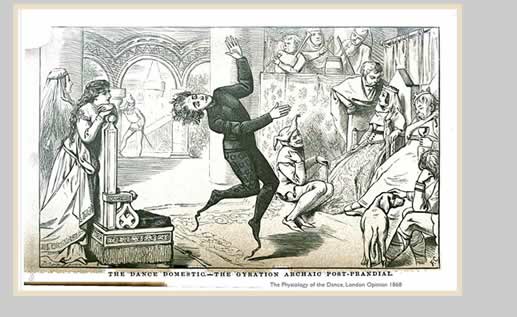Florence and Adelaide
Claxton arrear regularly as contributors to the illustrated magazines
of the period. There appears to have been a good representation of
women illustrators such as M.Ellen Edwards who only occasionally gave
a feminine perspective within the magazines on Society, on Love, Ambition
and Reverie. Comparatively little is known of Florence Claxton but she
gained celebrity with the exhibition of her watercolour The
Choice of Paris in the Portal Gallery in 1860, subsequently
published to a mass audience with an almost unprecedented two page colour
spread in the Illustrated
London News of June 1860, the
text accompanying the image showing every evidence of informed hints
from the artist herself (see beneath). The original watercolour is in
the collection of the Victoria and Albert Museum, London. It is known
that her father, Marshall Claxton was an artist who, after a period of
study in Rome found a voice in the 1840's as one of the sorry band of
monumental painters encouraged in the Palace of Westminster competitions.
In 1851 he had qualified professional success in Australia and on the
journey back worked in India and Egypt for three years. It is possible
then that his daughters were much travelled and aware of the art world
and its ways. By the late 1850's Florence was beginning to exhibit work
and have several of her illustrations published, particularly in
London Opinion.
TOP ROW - LEFT; "The
Choice of Paris: An Idyll by Miss Florence Claxton." Illustrated
London News 36
(2 Jun. 1860), 541-542.The text that accompanies the image runs,
"The
Pre-Raphaelites were smartly satyrised by Miss Florence Claxton in an
elaborate sketch, exhibited at the Portland Gallery, which, as and artistic
curiosity, we engrave on another page. The picture, as it will be seen,
is divided into two parts–one interior, the other exterior–by a brick
wall. In the interior, the left-hand compartment, the principal group
is that of Mr. Millais presenting the apple to a Pre-Raphaelite belle
ideal,
whom he prefers to a figure of Raphael’s (from the well-known picture
of "The
Marriage of the Virgin"),
and to a pretty, modern, English girl, dressed in the mode of
the day, with plaited hair and crinoline complete. He carries in his
hand a volume of Mr. Ruskin’s, and on the ground is a treatise "On
Beauty," by the same author. On the floor, also, are some of the
famous apple-blossoms which Mr. Ruskin invoked the artists of England
to paint, and the onions, as painted by Hunt, which that gentleman was
so enthusiastic about last year. Behind these we see another Pre-Raphaelite
worthy examining the feet of a female through a magnifying-glass, the
textural surface of which he is copying minutely in his sketch-book.
In the. background at this side is an artist of the middle ages thrusting
one of Raphael’s apostles out of the door; and on the opposite side are
the portraits of Raphael, Sir Joshua Reynolds, and Van Dyck, with their
faces turned to the wall, whilst those of Millais, Ruskin, and–Barnum
are exhibited underneath them to the homage of the public, whilst a mediæval
figure, reclining on a sofa, proclaims their ascendancy through a trumpet.
In the looking-glass over the mantelpiece is seen reflected the window
on the opposite side of the room, and through that window is discovered
the vision of a lady and gentleman walking up a gravel-path to church.
The countenance of the dandy sipping his tea at the left of the fireplace
is intended to express the bitterest feelings of horror and jealousy
at this to him unwelcome apparition. It will be recollected that in a
picture recently produced by Mr. Calderon a lovelorn lady is represented
as about to faint against the garden wall, having just caught a glimpse
of her lover presenting a flower to a girl on the other side of the wall.
In Miss Claxton’s "Idyll," the hapless fair one sees through
the brick wall, for the flower is being presented to her rival (who munches
an apple) inside the room, whilst she is standing outside in a Pre-Raphaelite
attitude of intense affliction. A little beyond this figure is seen an
artist making a careful study of a brick by the aid of an opera-glass.
Looking upwards, we discern a young lady who is being dragged in at the
window by the hair of her head, having lent too favourable an ear to
the serenading monk beneath. Her fiery red hair has partly given way
under the severity of the tension to which it is subject. Behind this
figure is the famous Sir Ysumbras [sic] of 1857, and in the foreground
a pic-nic, where Mr. Hunt’s "Scapegoat" is anxiously waiting
for some of the milk which a female (somewhat after one of the figures
in Mr. Millais’s "Spring") is drinking. The grave-digging nun,
and the sprawling figure of the girl sucking a straw, in the foreground
on the right, will at once be recognised as of the same paternity. This
crowded little composition will afford much amusement to the artistic
world and those who are up in professional incidents and tradition. There
are some follies which are better met by ridicule than argument, and
Pre-Raphaelitism is of them."
The composition is a witty fusion of visual features
from the main works of the Pre-Raphaelite artists, a sort of well constructed
tableau with accessories. The award of the prize by Millais to an attenuated
medieval figure instead of a more conventional ideal of beauty is consistent
with PUNCH's satirical attacks on the movement, typical of the conservative
belief in a Raphaelesque physical type. The tone of the Claxton watercolour
differs from PUNCH in that there is a certain fondness for the motifs,
and even an admiration for the technical complexities in the detail.
Claxton weaves an acid purple hue through the tableaux that is very characteristic
of the movement. I can't think of another such sucess de scandale in
the period that uses this satirical model, knowing winks to a shared
knowledge, fusing the whole into a persuasive whole. It is a catalogue
of information that reads extraordinarily well. Her Idyll precedes
George Du Maurier's satirical exercises A
Legend of Camelot (1866) which gets much nastier with its
references to siupposed preciosity and homosexulaity in the Brotherhood.
The three examples of her work from London
Society are
highly traditional in composition and narrative. Her drapery style, of
line and decoration is a high standard of drawing. The narrative impulse
in her is best expressed by the comparative pairing of men's and women's
dreams, a combination of the erotic and the violent. Her suitors heads
are mounted on the wall as trophies, his comes off to a cannonball.
The later drawing is one of a series of satires on Dances through the
Ages (1868) |



















